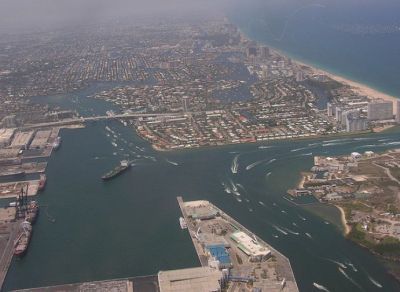
An environmental fight is brewing over plans by Port Everglades to blast and dredge a deeper entrance channel to accommodate the super freighters that are beginning to dominate the world’s trade routes.
The $321 million project would deepen the channel to 50 feet from 42 feet, and make other improvements to safely accommodate bigger ships. It would have a dramatic impact on one of the region’s busiest economic engines, a port for cruise ships, cargo ships and petroleum tankers that accounts for 10,000 jobs in direct employment and helps diversify a tourism-dependent economy.
But several state and federal environmental agencies say it could also have a dramatic impact on coral reefs, sea grass and endangered species.
The Army Corps of Engineers recently completed its latest draft environmental impact statement, which it declined to make public, saying the completed draft would be released early next year.
Several state and federal agencies that reviewed the draft were sharply critical of it, filing letters this summer that said the Corps understated the likely damage to natural resources. The National Marine Fisheries Service said the destruction of 15 acres of coral reef along the entrance channel would constitute impact on an “unprecedented scale” and threatened to take the issue to the White House Council on Environmental Quality if its concerns were not adequately addressed.
Meanwhile, Port Everglades faces competition from ports along the east coast of the United States, which are racing to dredge deeper accommodations in anticipation of the widening of the Panama Canal.
Changing trading patterns
The 48-mile canal is undergoing an expansion that is expected to transform trading patterns between Asia and the United States.
Ships from Asia typically dock at west coast ports such as Los Angeles or Long Beach, where automobiles, flat-screen televisions and other exports are loaded onto trains and trucks for distribution throughout the United States.
But with the widened canal, expected to be completed in 2014, the big ships will be able to deliver these goods directly to east coast ports. To accommodate ships that could be 1,000 feet long and 140 feet wide, several ports — including those of New York, Norfolk, Baltimore, Charleston, Savannah, Jacksonville and Miami — are planning or engaged in projects to deepen to 50 feet.
Port Everglades
Conceived in the early 20th century as an outlet for local cotton, sugar, fruit and other agricultural products, Port Everglades has grown into one of the nation’s major seaports.
Its busiest trade routes run to the south — the Caribbean, Central America and South America. Among the leading imports are fruit, vegetables, beer, tiles, underwear and T-shirts. Among the major exports are paper, groceries, scrap metal, frozen chickens, auto parts, building materials and electronics.
Although the United States has run a trade deficit for years, Port Everglades runs a $2.7 billion surplus.
“We’re exporting cell phones and computer printers out of Port Everglades to South America and the rest of the world,” said port director Phil Allen. “And those are U.S. jobs that are being supported.”
The port already does a lot of business through the canal. Port Everglades and the Panama Canal Authority last week announced a renewal of an agreement on joint advertising and market research, including the “All-Water Route” campaign to promote trade with Asia via the canal.
But to keep up, the port needs to dig a deeper channel, Allen said. It’s cheaper to transport goods on one giant ship rather than two smaller ones, he said. By next year the large ships that require a wider canal will be handling 64 percent of goods shipped overseas even though they make up only 30 percent of the ships.
“The world of international trade is going to larger ships,” he said.
Environmental impact
Several environmental agencies have objected strongly to elements of the plan, particularly since dredging and blasting would destroy part of a coral reef.
The Florida Department of Environmental Protection called for further study of the impact of blasting during sea turtle nesting season. The Florida Fish and Wildlife Conservation Commission said the destruction of sea grass would harm the manatees that cluster around the warm water discharges of the Florida Power & Light plant.
The National Marine Fisheries Service was particularly critical, saying the project would destroy an extensive stand of coral reefs, make it more difficult for threatened Elkhorn and Staghorn corals to reproduce. The fisheries service’s southeast regional administrator, Roy Crabtree, threatened to elevate the matter to the White House Council on Environmental Quality, which acts as referee in disagreements among federal agencies.
Laura Reichold, the Corps’ project manager, acknowledged the port’s location made it a challenging place to engage in a major engineering project, but she said the Corps would address the agencies’ concerns.
This “is an opportunity for the Corps to show that we can accomplish this project in a sustainable manner and avoid and mitigate for any impacts,” she said.
Next steps
Any work to deepen the port is years away. The Corps plans to release a draft impact statement to the public early next year. If environmental challenges don’t delay the plan and the Corps concludes the project should be done, it will go to Congress for authorization in 2013.
Given the lack of money in the federal budget, it may be years before the project wins approval. That’s one reason Gov. Rick Scott in March authorized the state to pay the federal share of the cost of deepening the Port of Miami to 50 feet.
Port director Allen said a realistic goal would be to complete the project and have the port ready for the big ships by 2017.
We use cookies to improve your experience. By continuing to use our site, you accept our Cookies, Privacy Policy,Terms and Conditions. Close X